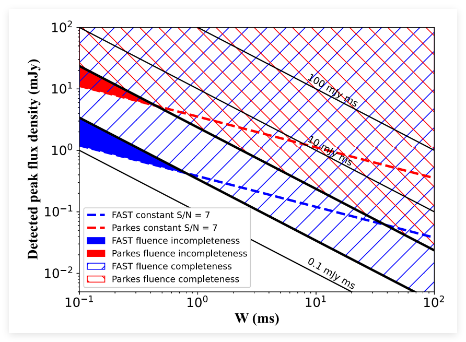
In the vast cosmos, fast radio bursts (FRBs) remain one of the most mysterious astrophysical phenomena ever discovered. These intense, millisecond-duration radio pulses can release in the radio band alone as much energy as the Sun emits in a day—or even a year. Yet, their origins remain elusive.
In a new effort to uncover clues, a research team led by Dr. BAI Juntao, a PhD student at the Xinjiang Astronomical Observatory (XAO) of the Chinese Academy of Sciences (CAS), under the supervision of Prof. WANG Na, conducted a comprehensive search for FRB-like emissions from pulsing ultraluminous X-ray sources (PULXs). The study involved collaborators from Guangzhou University, the Commonwealth Scientific and Industrial Research Organisation (CSIRO) of Australia, and the Purple Mountain Observatory of CAS.
Their results were published in The Astrophysical Journal.
PULXs are a class of neutron star-powered ultraluminous X-ray sources whose X-ray luminosities significantly exceed the Eddington limit, indicating the presence of super-Eddington accretion processes. In such extreme physical conditions—especially during energetic accretion outbursts—some models suggest that these systems may be capable of producing FRBs.
To test this hypothesis, the researchers performed deep, high-sensitivity radio observations of eight PULXs using the Five-hundred-meter Aperture Spherical radio Telescope (FAST) in China and the Parkes radio telescope (Murriyang) in Australia. Observations spanned a wide range of orbital phases and employed both single-pulse and periodicity search techniques, scanning dispersion measures from zero to 5,000 pc cm⁻³.
Despite these efforts, no significant FRB-like radio pulses were detected from any of the observed sources.
This result suggests that if FRB-like activity occurs in PULX systems, it is likely to be extremely rare, or the radio signals may be absorbed or scattered by strong accretion-driven winds, dense magnetized environments, or simply beamed away from Earth. The researchers also established stringent upper limits on the radio flux densities of the targets, placing strong observational constraints on theoretical models linking PULXs to FRBs.
This study represents the first dedicated FRB search focused on PULX systems, providing valuable observational evidence to assess the possibility of FRB generation in compact binaries. In addition, it places meaningful constraints on the increasingly discussed "binary-origin" hypothesis for FRBs and expands the observational frontier in the search for FRB progenitors.
This work was supported by the National Natural Science Foundation of China and the National Key R&D Program of China.

The flux density width parameter space (Image by XAO)

86-10-68597521 (day)
86-10-68597289 (night)

52 Sanlihe Rd., Xicheng District,
Beijing, China (100864)

